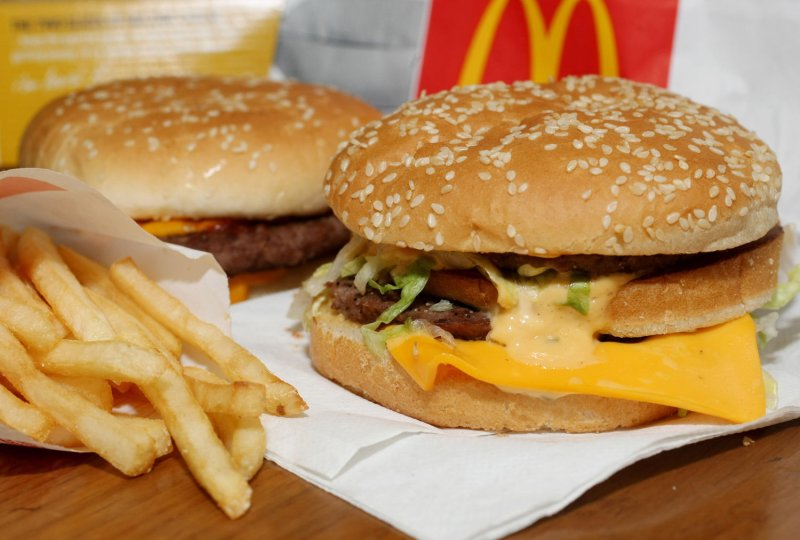1 of 3 | A McDonald's Big Mac and a small side of fries, containing a combined 1,200 mg of sodium, almost half of the daily recommendation, is seen at a McDonald's restaurant in New York on January 11, 2010. The city's health department is calling on food manufacturers to lower the amount of salt levels used in their food stating the health risks associated with the high intake. UPI/Monika Graff |
License Photo
CHICAGO, May 15 (UPI) -- Dining out is an evolving experience with restaurants trying out not only new cuisines but new ways of getting their fare to diners.
This year is shaping up to be the best since 2007 for the industry, said Hudson Riehle, senior vice president for research for the National Restaurant Association, and innovation is the key. Sales in 2011 are expected to reach $604 billion, up 3.6 percent from 2010, with 26 percent of operators saying food costs are their greatest concern now, not the economy.
The association says data indicate households spend 49 percent of their food budgets on restaurants, compared with 25 percent in 1955. And surveys indicate consumers are just waiting for the economy to improve to up that number even further.
That assessment is backed up by CIT Group, which in its restaurant industry outlook says Americans are suffering from "frugality fatigue."
One of the biggest trends in the industry is the food truck -- not a construction site's typical food wagon offering pre-packaged sandwiches and bad coffee, but mobile kitchens offering a variety of cuisines and using social media to tell potential customers where and when they'll be set up and what they'll be serving.
So you can create a flash mob for a food truck?
"Yes," Riehle laughed. "There was a lobster roll truck on the street at lunch time. It must have had 150 people lined up.
"You can look at it as a way of driving additional growth. The off-premises market … has been important to the industry and will continue to be important. The development of food trucks is driven by existing brands and also driven by independent chef-owners looking for the opportunity to express their culinary talents."
Whether or not cities are seeing these food trucks depends largely on local ordinances. The most buzz is coming out of New York, Los Angeles and Washington, as well as Miami to some extent, Riehle said. Efforts are under way to change regulations in Chicago and other cities to permit wider operation.
The 2011 Restaurant Industry Forecast found 47 percent of consumers surveyed said they'd be willing to patronize food trucks operated by their favorite restaurants.
Though food trucks are expected to be the star at the restaurant association's annual convention, which begins Saturday at McCormick Place in Chicago, they're not the only innovation.
There's also the now-you-see-it, now-you-don't pop-up concept.
Riehle said restaurant success always has revolved around points of access. The pop-up allows restaurants to set up temporary operations in the middle of a mall or in any vacant retail space during busy times and take down the operation once traffic thins out.
Riehle said these pop-ups generally offer slimmed down selections and many are chef-owned and operated. Social media also play a role, communicating the temporary availability on a real-time basis.
And in the traditional sit-down restaurant? Expect to see more food kiosks allowing patrons to place their orders directly with the kitchen. Apple is even promoting the iPad as a tableside ordering device and kiosks can provide consumers much more information, including preparation techniques, than does the traditional menu.
"Younger consumers show a higher propensity" toward using kiosks, Riehle said research indicates. And that's good news for restaurant operators trying to hold down labor costs.
About 10 percent of the workforce -- some 12.8 million people -- work at the nation's 960,000 restaurants, with sales representing 4 percent of the gross domestic product.
In 2011, quick-service restaurants are expected to post stronger sales growth than full-service, sit-down venues and the industry itself is expected to be a force in the economic recovery, with hiring projected at 2.4 percent, compared with 1.8 percent for the economy as a whole, the restaurant group's figures indicate.















